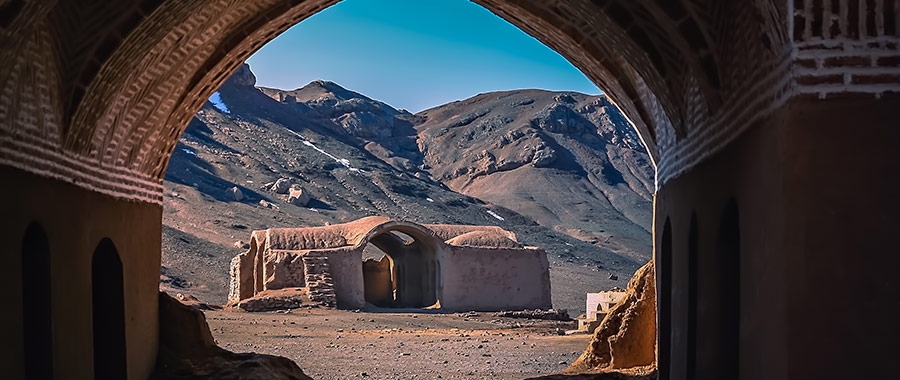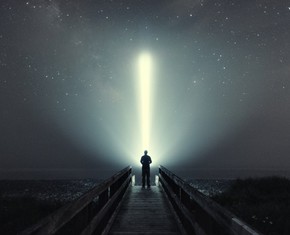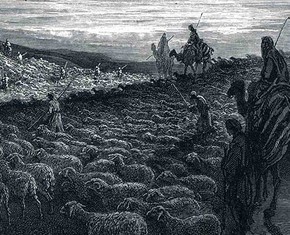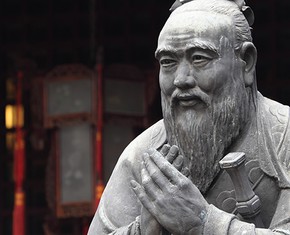The views expressed in our content reflect individual perspectives and do not represent the authoritative views of the Baha'i Faith.
Few Westerners know or understand much about the ancient Persian religion of Zoroastrianism. If we know anything, we probably recall the great Strauss composition, Also Sprach Zarathustra.
Strauss composed his famous orchestral tone poem in 1896, inspired by Friedrich Nietzsche’s philosophical novel, also called Also Sprach Zarathustra in German, or Thus Spoke Zarathustra in English. If you’ve seen the film 2001: A Space Odyssey, you know the rousing initial fanfare of Strauss’ music.
If you’ve read Nietzsche’s novel—the full title is Thus Spoke Zarathustra: A Book for All and None—you know that it fictitiously tells of the speeches, teachings and travels of Zarathustra, usually known in English as Zoroaster. Nietzsche wrote:
Zarathustra was the first to consider the fight of good and evil the very wheel in the machinery of things: the transposition of morality into the metaphysical realm, as a force, cause, and end in itself, is his work.
As Nietzsche’s book suggests, in the comparative study of apocalyptic literatures, Zoroastrian teachings and texts—which are unique in their own right—have a great deal of wisdom to offer us.
But Zoroastrians edited the Shah Bahram prophecies, in their final form, after the conquest of Iran by Arab Muslims, during the rapid expansion of the Islamic Empire in the seventh century CE. This sudden loss of everything the Zoroastrian Persians held dear—nationally, culturally, socially, economically as well as religiously—was catastrophic.
In prophecies foretelling the appearance of Shah Bahram, the main scenario is basically that of a king coming back to power by overthrowing the existing regime. Here, that rogue regime is described as that of “the Arabs”—whose morals, manners, way of life, and complete subjugation of Persian Zoroastrians is greatly despised and resented.
As former conquerors, the Persians were now among the conquered. The vanquishers had suddenly become the vanquished. A veritable axis shift and ethnic global change had taken place in the world of Persian Zoroastrianism, whose good fortune was irretrievably reversed. So a real yearning for deliverance was projected and prophesied into the future as a kind of collective consolation—by keeping alive and sustaining hope for a better future—in order to endure the present hardships under which the Persian Zoroastrians were chafing, languishing, and suffering.
In a sense, there was no way out, except to wish and hope for some kind of miraculous deliverance in the future. In that sense, the Zoroastrian Shah Bahram prophecies are really collective wishes for an improved life and collective destiny. What better way than to project, into and onto the future, the former golden age of times past, when Zoroastrianism was the state religion and Persian culture dominated its part of the world?
That said, we must not judge the Shah Bahram prophecies harshly. After all, they are products of their own time and place. They exhibit aspects of religious nationalism and ethnocentrism. All things considered, we must understand that the Zoroastrians were “Aryan” peoples, with a proud heritage and former prestige—which may help explain why Nietzsche wrote about Zoroaster in such an admiring way.
By the same token, the Zoroastrian prophecies themselves cannot be the measure of a future that is so far removed from the early post-Islamic period as to be beyond the pale of religious imagination.
So what does it really mean to say that a prophecy is fulfilled? Is this faithful to the letter? Or to the spirit?
Most apocalyptic texts envision a world in which a particular religious tradition itself—whether Christianity, Islam, Zoroastrianism, or another religion—is renewed, revitalized, re-empowered and ultimately restored to its former power and glory. If that alone was the measure of prophetic “fulfillment,” then virtually none of these prophecies would ever be fulfilled! At least not in the religiously pluralistic world in which we now live, where it is inconceivable that one religion would somehow gain ascendancy over all others. That’s simply not going to happen.
Zoroastrianism was once a universal religion, and to the extent that the religion became exclusively “Persian” and “Parsee” it became correspondingly limited. Given globalization today, ancient prophecies, which were limited glimpses of the future (if they truly glimpsed the future at all) were circumscribed by their own time and place. If they are truly to be fulfilled, such prophecies must be updated and evaluated with reference to this new day and age.
Fulfillment can be seen as the “best possible scenario”—not just for one religion or people or ethnicity. This may not be in accordance with the wishes of those who wrote the prophecies, especially the Zoroastrian priests who promulgated the Shah Bahram prophetic scenarios, which involved apocalyptic battles, with war elephants, archers shooting myriads of arrows from turrets atop the elephants—scenes that could not possibly take place today. In any case (and probably in every case) such prophecies have to be radically reconceived and reinterpreted.
This is basically what Baha’u’llah has done in proclaiming the fulfillment of Zoroastrian prophecies, and of the prophecies of the other great world religions. Such fulfillment is not literal, but spiritual. It goes far beyond the limited visions and unlikely scenarios of the prophecies themselves, and endows them with a new dimension of meaning and significance.
In the previous article, the very real prospect of the ultimate demise of the Zoroastrian religion was mentioned, due to dwindling numbers (and also due to a long-standing policy against accepting converts). If, God forbid, Zoroastrianism eventually does become extinct, then would its glorious prophecies have failed, and come to naught? Well, yes and no.
Yes, because there would be no practicing Zoroastrians left. The sacred fires in Zoroastrian temples would be extinguished. With the priests, rituals and communal identity gone, there would be nothing left but the historical legacy of Zoroastrianism, an ever-distant memory.
No, because, of the remaining world religions, only the Baha’i Faith would perpetuate the name and fame of the great prophet Zoroaster, and honor his memory. Not only that, but there are a considerable number of Baha’i tablets revealed for Zoroastrians. So much so that these have been compiled into two books, one in Persian, and the other in English: (1) Yārān-i Pārsī (Hofheim-Langenhain, Germany: Baha’i-Verlag, 1998); and (2) The Tabernacle of Unity (Haifa: Baha’i World Centre, 2006).
Although none of the Zoroastrian rituals are preserved in Baha’i practice, Baha’is celebrate a revised (Baha’i) version of the ancient Persian new year, called Naw-Ruz (“New Day”), which is a time-honored and venerable Zoroastrian celebration. Moreover, the Baha’i Calendar, in certain respects, is similar to the Zoroastrian calendar.
As Shoghi Effendi wrote:
Only those who are willing to associate the Revelation proclaimed by Baha’u’llah with the consummation of so stupendous an evolution in the collective life of the whole human race can grasp the significance of the words which He, while alluding to the glories of this promised Day and to the duration of the Baha’i Era, has deemed fit to utter. “This is the King of Days,” He exclaims, “the Day that hath seen the coming of the Best-Beloved, Him Who, through all eternity, hath been acclaimed the Desire of the World.” “The Scriptures of past Dispensations,” He further asserts, “celebrate the great jubilee that must needs greet this most great Day of God. Well is it with him that hath lived to see this Day and hath recognized its station.” “It is evident,” He, in another passage explains, “that every age in which a Manifestation of God hath lived is divinely-ordained, and may, in a sense, be characterized as God’s appointed Day. This Day, however, is unique, and is to be distinguished from those that have preceded it. The designation ’Seal of the Prophets’ fully revealeth its high station. The Prophetic Cycle hath verily ended. The Eternal Truth is now come. He hath lifted up the ensign of power, and is now shedding upon the world the unclouded splendor of His Revelation.” “In this most mighty Revelation,” He, in categorical language, declares, “all the Dispensations of the past have attained their highest, their final consummation. That which hath been made manifest in this préeminent, this most exalted Revelation, standeth unparalleled in the annals of the past, nor will future ages witness its like.” – Shoghi Effendi, The World Order of Baha’u’llah, pp. 166–167.
















Comments
Sign in or create an account
Continue with Googleor